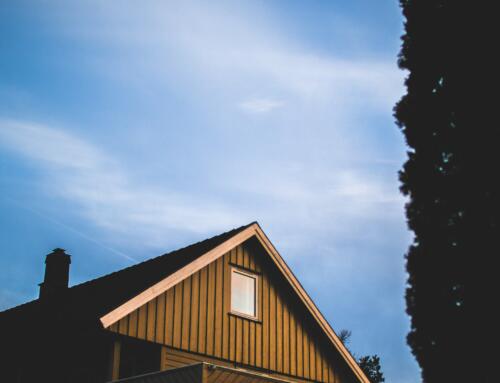Having trees growing on your property has many benefits, including providing shade, increasing your property value, improving air quality, and even improving your mental and physical health.
That being said, there also are risks to having trees on your property, particularly if they’re almost any structures.
What do you have to do if a tree falls on a house? Does insurance cover it?
Let’s take a glance at everything you would like to understand about what you ought to expect from your homeowner’s insurance within the event a tree falls on your home.
When a Tree Falls On a House: What Should You Do?
Things like high winds, lightning, and heavy rain are common culprits which will cause a tree to fall on your house. Knowing what to try to do before the time is important to assist protect your family and help mitigate damage to your home.
Immediately Evacuate
When something unexpected happens, like when a tree falls on your house, the amount one priority is that the safety of your loved ones. Have an evacuation plan in situ just in case of such an emergency. this suggests your family is all cognizant of the simplest exit routes and where you all decide to safely meet.
It’s also an honest idea to possess emergency bags packed and prepared just in case the unexpected happens. These can have essential items sort as a care kit, necessary medication, extra clothes, car keys, copies of important documents, and a few cash.
Call 911
Once your family has safely evacuated, call emergency services and inform them of what happened. they’re going to possibly send a utility representative or fire crew to form sure your house is safe.
Even if the branch or tree that fell on your house seems small, don’t attempt to affect the matter all on your own. You especially don’t want to climb onto your room while a storm goes on. Rooftops are often slippery from rain, heavy winds can cause you to lose your footing, or the fallen tree could have compromised the structural integrity of your roof.
Contact Your insurance firm
The next step after a tree falls on your home is to offer your insurance firm a call. We’ll take a glance at what to expect from your insurance firm within the next section.
Find a Trustworthy Roofing Contractor
When something as important as your home’s roof is at stake, it’s vital to seek out a trustworthy contractor. Unfortunately, you’ve got to be wary of storm chasers, who scam homeowners and cash in of their desperate situation.
Having an honest, local roofing contractor picked out before time just in case of such an emergency can assist you to avoid having to form a but ideal choice. You don’t want to be within the position where you’ve got to require the primary contractor you’ll find.
Secure Your Home
If the damage to your house is substantial enough, you would possibly not be ready to live there directly. If you’re staying elsewhere while the repairs are made, confirm to lock all of your windows and doors. Secure anything valuable on the off chance that somebody breaks into your home.
Does Homeowners Insurance Cover Tree Removal After a Storm?
Whether or not tree removal is roofed by your insurance has got to do with where the tree fell and what caused it to collapse.
If a tree falls due to wind, fire, lightning, riot, explosion, aircraft, vandalism, theft, or vehicles you don’t own, insurance will likely cover tree removal. this is often true in both the case that a tree falls on your home and if it falls on your lawn or empty property space.
Similarly, if a flood or an earthquake causes a tree to fall anywhere on your property, including your home, this won’t be covered unless you’ve got special extra coverage.
If a storm, ice, or hail takes a tree down, the removal is going to be covered if the tree falls on your house. If a tree falls on your lawn or space in these same circumstances, however, your homeowner’s insurance presumably won’t cover it.
In these instances, if a tree falls on a shed or the other structure of your home, this can be covered an equivalent as if it fell on your primary home.
What do you have to do if your neighbor features a diseased, defective, or dying tree, or potentially hazardous limbs, that would fall onto your property? the primary thing you would like to try to do is to ask your neighbor and explain things from your perspective and ask them to repair the matter. Then you’ll want to send them a letter putting them on notice for the hazardous tree.
It’s an honest idea to require photographs and document the matter tree. Keep a replica of the letter you send and send it through certified mail.
Does Homeowners Insurance Cover Damage to My Home?
If a tree fell on your house, a typical homeowner’s policy will help buy repairing the damage. The insurance firm will decide whether the damage was caused by negligence or a maintenance-related issue, however, this won’t affect your coverage for the loss. thereupon said it’s still an honest idea to try preventative maintenance to your property to avoid potential claims. for instance, if you’ve got old or rotting trees on your property, it’s a really good idea to possess them taken down before a subsequent storm.
Neighbor’s Tree Fell On My Property: What Now?
If you discover that a neighbor’s tree has fallen on your property, you would possibly be worried this complicates your coverage. Actually, though, your homeowner’s insurance should still cover the removal altogether equivalent instances they might if it had fallen on your own property.
Your insurance firm may attempt to follow your neighbor’s insurance firm to recoup their losses.
It’s also important to understand that if a tree fell on your car from your neighbor’s property, the removal will likely only be covered if it’s thanks to lightning, riot, explosion, aircraft, vandalism, theft, or vehicles not owned by you. this is often because cars aren’t typically included in homeowner’s policies, and thus would be treated as “space.”
How Much Does Insurance Pay Towards Tree Removal?
When a tree falls on your property, contact your insurer to find out what proportion of coverage you’ll receive support the circumstances of the claim.
If the tree falls on your house or another structure, your home policy will likely completely cover the removal of the tree from the structure. If the tree has simply fallen in “space” and not on a structure or a vehicle, contact your insurance broker or check your policy to seek out out what proportion coverage you’ll receive.
How Much Does Homeowners Insurance protect a Structure Damaged By a Tree?
The answer to the present question goes to depends upon your specific policy. once you found out your policy, you comply with certain coverage limits. These are what determine what proportion of money your insurer will spend repairing your home from tree damage.
Your limit is that the maximum dollar amount your policy can pay for any covered claim. it’s possible and certain that you’ll have separate coverage limits for dwellings and other structures on your property.
Dwelling coverage is what helps cover the repair costs if your home has been damaged by a covered peril. Other structures coverage is what helps pay to repair the other structures on your property, for instance, a fence or a shed.
Here’s an example. If you set your dwelling coverage limit for $400,000 once you purchased your policy, then your policy might help to ante up to $400,000 to rebuild or repair your home. Don’t forget, though, that you’ll be liable for paying your deductible, which you sometimes choose once you purchase the coverage.
Choosing home insurance for your property is some things that you simply want to try to do right the primary time. It is often an honest idea to try to do an annual check-up into your policy to form sure that you simply have the coverage you would like. If there are changes in your property, family size, or the price of your possessions, you would possibly want to form changes to your policy.
Should You File a Claim?
You’ll want to require your deductible under consideration when deciding whether or to not make a claim. If your deductible is $1000, it wouldn’t add up to file a claim for one fallen tree that caused no damage. On the opposite hand, if a tree did damage to your home which will be costly to repair, the cost-effective option is probably going to file a claim.
Taking an honest check out of your insurance plan is vital when it’s time to decide whether or to not make a claim. Take the time to find out whether or not making a claim will raise your premiums.
You also won’t want to form a claim if you latterly made a special homeowner’s claim. If you file too many claims during a short period of your time, your insurance firm might prefer to not renew your policy. this suggests that they will drop you as a policyholder as they deem you as too high risk.
Unfortunately, your claims activities will follow you from one insurance firm to a different one. this is often because insurance companies have access to something called the great Loss Underwriting Exchange, or CLUE. This database includes all the knowledge about the date, amount of coverage, and damage that was paid out by your insurance firm.
This means that albeit you are trying to urge a replacement insurance firm due to raised premiums at your current company, you won’t necessarily be starting with a fresh start.
How to Recognize a Tree Hazard On Your Property
While some events in our lives begin of nowhere, it’s best to stop avoidable disasters. this suggests that if there are trees that are hazardous on your property, you would like to require care of them before they are available down on their own.
One of the foremost obvious and visual tree hazards is that if there are broken or hanging limbs. Sometimes, though, it takes a knowledgeable tree inspector to ascertain splits and cracks in limbs to understand just how severe the damage is.
Dead limbs are another thing to seem out for within the trees in your yard. These are often sometimes hard to identify, especially within the winter, and pose a fall risk.
Another thing to seem out for is changes within the tree bark. While you would possibly be ready to detect this yourself, you’ll need a professional to require a glance. They’ll have a far better sense of whether or not changes within the bark are indicative of a drag.
An obvious thing to seem out for is trees that are leaning in a problematic way. A leaning tree isn’t necessarily unstable, but it’s something to ask knowledgeable about if you’re unsure.
Root damage is another thing that will lead trees to become hazardous. If there has been recent construction on or near your property, it’s possible that your tree’s roots were damaged within the process. Wilting, thinning foliage, dead branches, undersized leaves, and limited growth are all signs that the roots of the trees could be damaged.
Lastly, keep an eye fixed out for trees that are exposed and weekend. If your lot has been cleared leaving only a couple of trees standing, these trees aren’t won’t be so exposed. Without the windbreak they previously had within the sort of the opposite trees, these remaining trees are far more vulnerable to wind damage.
Contact Best Roof And Gutter
Feel free to fill out a FREE estimate or call us at (720) 443-5386





